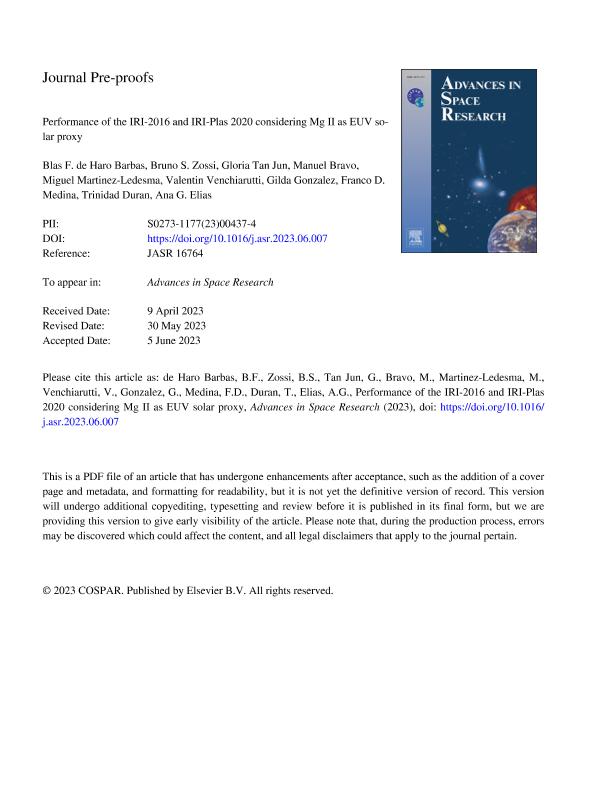Artículo
Performance of the IRI-2016 and IRI-Plas 2020 considering Mg II as EUV solar proxy
de Haro Barbás, Blas Federico; Zossi, Bruno Santiago ; Tan Jun Rios, María Gloria; Bravo, Manuel; Martínez Ledesma, Miguel; Venchiarutti, José Valentín
; Tan Jun Rios, María Gloria; Bravo, Manuel; Martínez Ledesma, Miguel; Venchiarutti, José Valentín ; González, Gilda de Lourdes
; González, Gilda de Lourdes ; Medina, Franco Dario
; Medina, Franco Dario ; Duran, Trinidad
; Duran, Trinidad ; Elias, Ana Georgina
; Elias, Ana Georgina
 ; Tan Jun Rios, María Gloria; Bravo, Manuel; Martínez Ledesma, Miguel; Venchiarutti, José Valentín
; Tan Jun Rios, María Gloria; Bravo, Manuel; Martínez Ledesma, Miguel; Venchiarutti, José Valentín ; González, Gilda de Lourdes
; González, Gilda de Lourdes ; Medina, Franco Dario
; Medina, Franco Dario ; Duran, Trinidad
; Duran, Trinidad ; Elias, Ana Georgina
; Elias, Ana Georgina
Fecha de publicación:
06/2023
Editorial:
Elsevier
Revista:
Advances in Space Research
ISSN:
0273-1177
Idioma:
Inglés
Tipo de recurso:
Artículo publicado
Clasificación temática:
Resumen
To assess upper atmosphere parameters, current models use different variables to account for solar activity levels. Studies that evaluate the most recent solar cycles have shown that when dealing with the ionospheric F2 layer, and in particular with foF2, the Mg II index is a better choice than other solar activity proxies to account for solar EUV variation. The International Reference Ionosphere, version 2016 (IRI-2016), a model widely used by the scientific community, uses the Ionosonde Global (IG) index to assess foF2. A most recent and expanded version, IRI-Plas, allows selecting a solar activity proxy among 7 options including IG and Mg II. In the present work, the performance of IRI considering Mg II to assess foF2 is analyzed, comparing three modeling cases: IRI-2016 with its default solar activity index (IG), IRI-2016 with Mg II instead of IG, and IRI-Plas choosing Mg II as the solar proxy option. This model comparison was evaluated in terms of their agreement with measured foF2 data from four stations located in Japan (Northern Hemisphere), and four in Australia (Southern Hemisphere). Monthly medians for the 24 h, along two periods of three years were considered: 2000–2002 and 2008–2010, which correspond to epochs of maximum and minimum solar activity levels, respectively. Based on goodness-of-fit statistics, our results show that in the case of IRI-2016, the Mg II implementation does not reveal a significant improvement for foF2 assessment, and the IRI-Plas performance with the Mg II option is only slightly better than the other two options. Dispersion diagrams between measured and modeled foF2 also evince a similar performance between the three models. All models show the same over- and underestimation patterns, except in the nighttime case during the minimum activity level period for both Australian and Japanese stations where IRI-Plas outperforms the other two model options. The comparable performances of the three options might be attributed to a stronger variation in the evaluated periods which could be related to seasonal changes rather than to solar EUV proxies. Future studies considering time series over several years, covering at least a complete solar activity cycle, are required to determine stronger model performance differences.
Archivos asociados
Licencia
Identificadores
Colecciones
Articulos (INFINOA)
Articulos de INSTITUTO DE FISICA DEL NOROESTE ARGENTINO
Articulos de INSTITUTO DE FISICA DEL NOROESTE ARGENTINO
Articulos(IFISUR)
Articulos de INSTITUTO DE FISICA DEL SUR
Articulos de INSTITUTO DE FISICA DEL SUR
Citación
de Haro Barbás, Blas Federico; Zossi, Bruno Santiago; Tan Jun Rios, María Gloria; Bravo, Manuel; Martínez Ledesma, Miguel; et al.; Performance of the IRI-2016 and IRI-Plas 2020 considering Mg II as EUV solar proxy; Elsevier; Advances in Space Research; 72; 6; 6-2023; 2406-2417
Compartir
Altmétricas



